The Holocene Mass Extinction Part 4: The Great Chain of Being
Up until now we've been discussing how humans are causing the Holocene Mass Extinction. Now, however, we're going to talk about the history of the idea of extinction itself- and it's not a very old idea in the scheme of things.
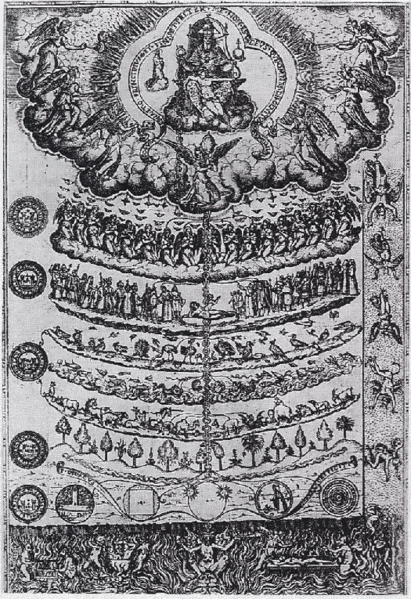
A 1579 illustration of The Great Chain of Being. [Image source]
Prior to the 18th century in Europe, the dominant theory of nature was the Great Chain of Being. This medieval Christian idea stated that nature was organized in a strict hierarchy. Rocks were at the bottom of the hierarchy, the Great Chain, and merely existed. Each additional level had all the spiritual attributes of the lower levels as well as gaining more of their own. Next were plants, then animals, then humans, then angels, and then, at the very top, was God. Each of these levels, with the exception of God's, were further subdivided. Some animals, like the lion, were higher up on the Chain than others, like mice. Some humans, like kings, were naturally above others, like peasants.
The Great Chain of Being was incredibly dominant and influential when it came to the European understanding of nature. It lay behind European Christendom's conviction that God had given them dominion over nature, in direct contrast to those Semitic sects that believed they had been given custodianship of nature instead. We can still see the influence of the Great Chain of Being in a lot of modern fundamentalist Christian theology in how they relate to nature, among other ways.
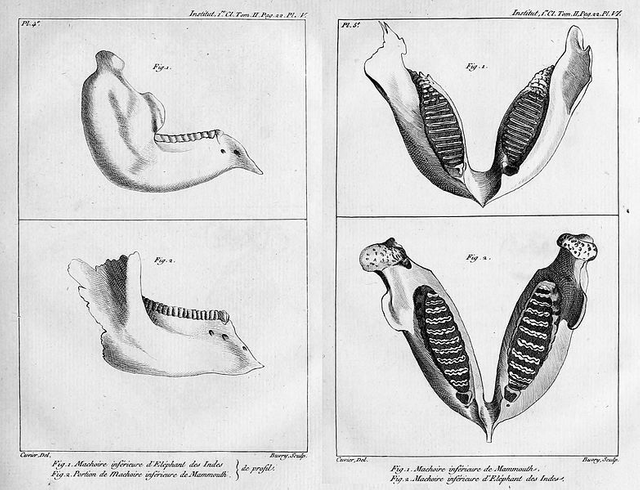
The jawbone of the extinct American mammoth inspected by Cuvier. [Image source]
For our purposes, however, there's one especially important aspect of the Great Chain of Being: it was immutable and unchangeable. Nothing could change levels in the hierarchy: A plant would always be a plant, a mouse would never be a lion, and a peasant would always just be a peasant. On top of that, nothing could be removed from the hierarchy, either- extinction as an idea was entirely theologically incompatible with The Great Chain of Being. God surely wouldn't wipe out his own creations- there was good reason for two of every animal being included on Noah's Ark.
The Great Chain of Being suffered its first shakeups during the Protestant Reformation, but they were relatively minor shakeups. The first major cracks didn't begin to show until the Enlightenment reared its head. But even as liberal theology, deism, democratic ideals, and all the other heads of the Enlightenment hydra were biting into the status quo, they weren't quite able to kill the Great Chain. (Despite referring to the Enlightenment as a hydra, I do, on the whole, consider it a good thing- but it's hardly the unalloyed good it's so often treated as today. More on that another time.) In fact, the Great Chain managed to imbed itself in Enlightenment thinking.
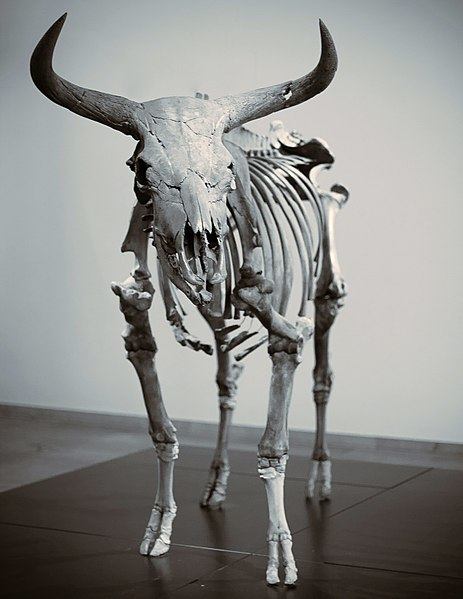
The Aurochs, the ancestor of European cattle. Ironically driven extinct by Europeans even as they denied that extinction could even occur. The last one was killed in 1627. The Aurochs is actually a potential candidate for de-extinction- a number of groups, including Nazi Germany, have attempted over the years to breed an aurochs out of European cattle stocks. [Image source]
In 1796, French naturalist Georges Cuvier presented a paper on all species of elephants- those living and those extinct. It was the first time anyone had seriously claimed that extinction was possible, and it was earth-shattering. Not just in the sciences, but across the intellectual playing field of the following decades. One of the key pieces of evidence was the fossil jawbone of the woolly mammoth, which Cuvier claimed- correctly- to be a completely separate species from the modern elephant.
Thomas Jefferson, one of the greatest of the Enlightenment thinkers, was a firm devotee of the Great Chain of Being. He was also obsessed with mammoths- referred to as incognitums prior to Cuvier, whose fossils were found everywhere in America. (Mastodons, really, but that distinction wasn't developed until later.) This led to his conclusion that mammoths still lived somewhere in the American wilds. This wasn't an original conclusion- claims that species still lived somewhere in the spaces of the world unexplored by Europeans were one of the primary defenses used by foes of the idea of extinction. Jefferson, however, eventually gained the power to act on it- there's little doubt that despite the many other good reasons for doing so, the search for woolly mammoths was the primary purpose of the Lewis and Clark expedition. In addition, Jefferson was engaged in a bit of a feud with the Comte de Buffon, who claimed that the American continent was degenerate and degraded its people and wildlife. (Jefferson won in a big way, enough that buffoon is now a common insult.)
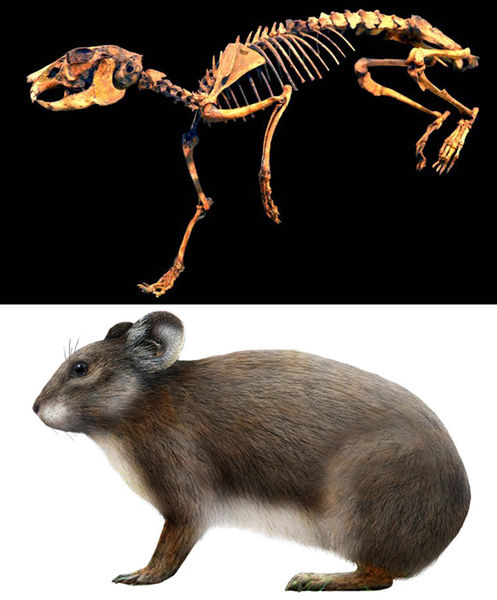
The Sardinian Pika, another European species ironically driven extinct in 1774, while Europeans still denied that extinction occurred. [Image source]
Despite the excellent evidence provided by Cuvier and his allies, acceptance of extinction was not a rapid process. As in the case of Jefferson, many of his opponents were found outside the Christian churches- very often within the sciences, in fact. Uniformitarians, for instance, were fierce foes of the idea of extinction. These early geologists believed, in short, that "the present is the key to the past", and that all of geological history was composed of processes currently active today. As such, they firmly rejected all catastrophic explanations for the history of the world- whether they be the Great Flood or extinction. Ironically, their work- especially in proving that the world was older than the 6,000 years claimed by the Church- was vital in Cuvier's discoveries. To add to the irony, Cuvier's ideas were instrumental in the foundation of the theory of evolution, which he himself rejected thoroughly.
While this is all an interesting bit of history, I'm not just including it for entertainment's sake. When examining modern views of nature, you can't help but find fragments of the shattered Great Chain of Being embedded throughout them. Much modern resistance to protecting our ecosystems and endangered species derives from it. It leads many to doubt that we can damage the ecosystem as heavily as we have. It leads many more to acknowledge that damage, but to claim that it's our prerogative, as God gave mankind dominion of the Earth to do with as we will. And if you want to face these sorts of ideas, just lumping fact after fact upon the bearer won't change their mind very well- you need to understand where their ideas come from so that you can confront them on their own ground.
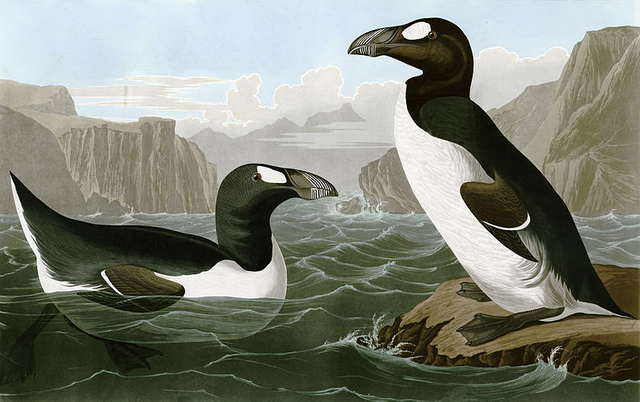
The Great Auk, once present off the coasts of Iceland and Northern Europe, driven extinct in 1854. Unrelated to the penguin, despite their similar appearance. This was one of the first European species that went extinct that Europeans were forced to accept as having done so. [Image source]
Bibliography:
The Sixth Extinction, by Elizabeth Kolbert
The Song of the Dodo, by David Quammen
Time's Arrow, Time's Cycle, by Stephen Jay Gould
https://en.wikipedia.org/wiki/Extinction
https://en.wikipedia.org/wiki/Georges_Cuvier
https://en.wikipedia.org/wiki/Great_chain_of_being
https://en.wikipedia.org/wiki/List_of_extinct_animals_of_Europe
https://en.wikipedia.org/wiki/Sardinian_pika
https://en.wikipedia.org/wiki/Great_auk
https://en.wikipedia.org/wiki/Aurochs
https://www.atlasobscura.com/articles/thomas-jefferson-built-this-country-on-mastodons
https://depositsmag.com/2016/12/23/thomas-jeffersons-mammoth-problem/

Although I disagree with the whole "dominion over the Earth and animal kingdom" (if it means "treat nature as you like, it will always regenerate magically; and animals never run out, kill as many as you wish"), and "a peasant will always be a peasant", etc., I still hold the Chain-of-Being's (and the Enlightenment's) belief that some creatures are superior to other creatures. For instance, if there's a car speeding toward a cat and a woman carrying her groceries and her child, I will save the woman&child rather than the cat. Does that make me a baddie?
Not in the least. Even the most dour, pragmatic materialist would say you did the right thing- though they might justify it with discussions of protecting your species gene pool or some such.
Here's an dilemma for you- what if it was an endangered species at risk of extinction, and losing this single breeding member could tip it over the edge? What if said endangered species was a keystone species in the local ecosystem?
It's a dilemma for sure. I would in most cases choose the creature that imo possesses the greater consciousness (see reply to @alexs1320 below). In your example case, I may put faith in humans being able to recreate (de-extinct) these species at some future time.
Interesting answer, I like it! (Also, my usual answer is somewhere along the lines of "fuck trolley problems.")
No, you are right, but your example is known in evolution as the "keen selection", you are saving your closer relatives (your brother is more important than a stranger, someone from your country is closer to you than some Inuit, etc...).
What would you choose: shark or salmon (salmon is "upper")
Or: Lemur vs Chimpanzee (chimpanzee is "upper" but lemurs are cute)
Or: some exotic unique lizard vs a juicy, tasty pig
What if I saved an alien (by definition not my gene pool) that I know has superior consciousness instead of the woman? What if I'd rather save Shakespeare than a cousin? Would that sufficiently falsify your theory that it's not my logical/moral mind talking, but evolutionary pressures to save my kin?
In all cases you mention, I would save the creature that in my opinion possesses greater consciousness. There could be exceptions, as in when two creatures of higher consciousness are more or less identical so having more that a few million becomes rather redundant :p (so maybe I would save the rare creature vs the common pig)
In case of Shakespeare, or your fellow soldier comrade vs traitor brother, you are saving the idea, what Dawkins is calling "the meme".
But I think we have that instinct to save our owns, or those like us. For example, you would hesitate for a second to destroy this coffee:
Now you made me crave a hot chocolate...
:)
I love that story about Jefferson and the mammoth, which I included in a piece about another big bit of culturally induced blindness from the same time period, the idea that Native Americans -- being lower on the Great Chain -- couldn't possibly have built any of the giant monuments scattered across the western continents.
http://www.intergalacticmedicineshow.com/cgi-bin/mag.cgi?do=columns&vol=randall_hayes&article=017
That's awesome! And I'd never heard of The Black List before- might need to give it a shot! :)
This is sure one interesting topic. Sometimes I think we are going to get extinct if we don't start changing our ways. And, if we continue like this, who knows where our destructive ways will lead us to.
Maybe someday aliens will have us in a framed glass with a plant on the saying "once upon a time lived a species of humans destructive by nature who lead themselves to extinction."
I loved how detailed your post. You really put a lot of time and effort in this one and it deserves every upvote it get ten fold. Amazing job. :)
Thanks!
Your post has been personally reviewed and was considered to be a well written high quality article!
You received a 60% upvote since you are a member of geopolis.
To read more about us and what we do, click here.
https://steemit.com/geopolis/@geopolis/geopolis-the-community-for-global-sciences-update-1
If you do not want us to upvote and comment on your posts concerning earth and earth sciences, please reply stop to this comment and we will no longer bother you with our love
Thanks!
I just read all 4 Parts at once and I'm sorry because Part 1 has expired.
Great style of writing, as I like to see posts where the topic is put into the wider context.
Thanks, I'm glad you enjoyed them! Keep an eye out for parts 5 and 6!
Looking forward
A great read, I found this very interesting. This era of science is fascinating!
Thanks for reading!
Humans have used science to create the technologies that are making life on Earth look less and less possible in the future. We must stop deforestation, eliminate nuclear power facilities, and end the use of filthy fossil fuels for energy. We should turn to clean abundant and widely available forms of energy such as wind, water, sun and the earth's internal heat as well as hydrogen found in every drop of water. Their abundance would make the use of warfare unnecessary.
@originalworks
The @OriginalWorks bot has determined this post by @mountainwashere to be original material and upvoted it!
To call @OriginalWorks, simply reply to any post with @originalworks or !originalworks in your message!
Very well written and presented, as usual!
Congratulations! This post has been chosen as one of the daily Whistle Stops for The STEEM Engine!
You can see your post's place along the track here: The Daily Whistle Stops, Issue #19 (1/17/18)
The STEEM Engine is an initiative dedicated to promoting meaningful engagement across Steemit. Find out more about us and join us today!